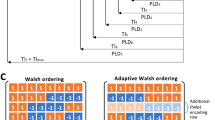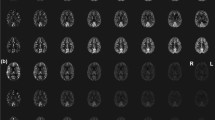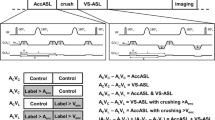Abstract
Objective
To compare arterial transit time estimates from two efficient transit time mapping techniques using arterial spin labeling (ASL)—flow encoded arterial spin tagging (FEAST) and Look-Locker ASL (LL-ASL). The effects of bipolar gradients and label location were investigated.
Materials and methods
Six healthy subjects were scanned with pseudo-continuous ASL (pCASL) FEAST and pulsed (PASL) and pCASL variants of LL-ASL at different labeling locations with and without bipolar gradients. Application of transit time mapping was demonstrated in a clinical case.
Results
Mean (±SD) macrovascular transit times were 363 ± 39, 676 ± 73 and 908 ± 170 ms for LL-PASL, LL-pCASL with labeling offsets of 60 and 90 mm respectively, showing linear dependence on labeling locations. Mean microvascular transit time for LL-pCASL was 1,463±135 ms, in good agreement with the FEAST estimate of 1,444 ± 128 ms. Data acquired from a patient with stroke demonstrate how transit time and CBF maps provide complementary information for clinical diagnosis.
Conclusion
Both FEAST and LL-ASL provide transit time information in clinically acceptable scan times. Bipolar gradients can be used to tailor transit time estimates for different experimental and clinical situations.
Similar content being viewed by others
Abbreviations
- ASL:
-
Arterial spin labeling
- CBF:
-
Cerebral blood flow
- rf:
-
Radio frequency
- TI:
-
Inversion time
- LL:
-
Look-Locker
- TR:
-
Repetition time
- FEAST:
-
Flow encoding arterial spin tagging
- TE:
-
Echo time
- PASL:
-
Pulsed arterial spin labeling
- pCASL:
-
Pseudo-continuous arterial spin labeling
- ROI:
-
Regions of interest
- SD:
-
Standard deviation
References
Wong EC, Buxton RB, Frank LR (1998) Quantitative imaging of perfusion using a single subtraction (QUIPSS and QUIPSS II). Magn Reson Med 39(5): 702–708
Alsop DC, Detre JA (1996) Reduced transit-time sensitivity in noninvasive magnetic resonance imaging of human cerebral blood flow. J Cereb Blood Flow Metab 16(6): 1236–1249
Kimura H, Kado H, Koshimoto Y, Tsuchida T, Yonekura Y, Itoh H (2005) Multislice continuous arterial spin-labeled perfusion MRI in patients with chronic occlusive cerebrovascular disease: a correlative study with CO2 PET validation. J Magn Reson Imaging 22(2): 189–198
MacIntosh BJ, Lindsay AC, Kylintireas I, Kuker W, Gunther M, Robson MD, Kennedy J, Choudhury RP, Jezzard P (2010) Multiple inflow pulsed arterial spin-labeling reveals delays in the arterial arrival time in minor stroke and transient ischemic attack. AJNR Am J Neuroradiol 31(10): 1892–1894
van Laar PJ, van der Grond J, Bremmer JP, Klijn CJ, Hendrikse J (2008) Assessment of the contribution of the external carotid artery to brain perfusion in patients with internal carotid artery occlusion. Stroke 39(11): 3003–3008
Figueiredo PM, Clare S, Jezzard P (2005) Quantitative perfusion measurements using pulsed arterial spin labeling: effects of large region-of-interest analysis. J Magn Reson Imaging 21(6): 676–682
Gonzalez-At JB, Alsop DC, Detre JA (2000) Cerebral perfusion and arterial transit time changes during task activation determined with continuous arterial spin labeling. Magn Reson Med 43(5): 739–746
Yang Y, Engelien W, Xu S, Gu H, Silbersweig DA, Stern E (2000) Transit time, trailing time, and cerebral blood flow during brain activation: measurement using multislice, pulsed spin-labeling perfusion imaging. Magn Reson Med 44(5): 680–685
Gunther M, Bock M, Schad LR (2001) Arterial spin labeling in combination with a look-locker sampling strategy: inflow turbo-sampling EPI-FAIR (ITS-FAIR). Magn Reson Med 46(5): 974–984
Wang J, Alsop DC, Song HK, Maldjian JA, Tang K, Salvucci AE, Detre JA (2003) Arterial transit time imaging with flow encoding arterial spin tagging (FEAST). Magn Reson Med 50(3): 599–607
Buxton RB, Frank LR, Wong EC, Siewert B, Warach S, Edelman RR (1998) A general kinetic model for quantitative perfusion imaging with arterial spin labeling. Magn Reson Med 40(3): 383–396
Kim SG (1995) Quantification of relative cerebral blood flow change by flow-sensitive alternating inversion recovery (FAIR) technique: application to functional mapping. Magn Reson Med 34(3): 293–301
Mugler JP 3rd, Brookeman JR (1990) Three-dimensional magnetization-prepared rapid gradient-echo imaging (3D MP RAGE). Magn Reson Med 15(1): 152–157
Tatu L, Moulin T, Bogousslavsky J, Duvernoy H (1998) Arterial territories of the human brain: cerebral hemispheres. Neurology 50(6): 1699–1708
Wang J, Alsop DC, Li L, Listerud J, Gonzalez-At JB, Schnall MD, Detre JA (2002) Comparison of quantitative perfusion imaging using arterial spin labeling at 1.5 and 4.0 Tesla. Magn Reson Med 48(2): 242–254
Liu P, Uh J, Lu H (2011) Determination of spin compartment in arterial spin labeling MRI. Magn Reson Med 65(1): 120–127
Mildner T, Moller HE, Driesel W, Norris DG, Trampel R (2005) Continuous arterial spin labeling at the human common carotid artery: the influence of transit times. NMR Biomed 18(1): 19–23
Wells JA, Lythgoe MF, Choy M, Gadian DG, Ordidge RJ, Thomas DL (2009) Characterizing the origin of the arterial spin labelling signal in MRI using a multiecho acquisition approach. J Cereb Blood Flow Metab 29(11): 1836–1845
Wang J, Fernandez-Seara MA, Wang S, St Lawrence KS (2007) When perfusion meets diffusion: in vivo measurement of water permeability in human brain. J Cereb Blood Flow Metab 27(4): 839–849
Cebral JR, Castro MA, Putman CM, Alperin N (2008) Flow-area relationship in internal carotid and vertebral arteries. Physiol Meas 29(5): 585–594
Marshall I, Papathanasopoulou P, Wartolowska K (2004) Carotid flow rates and flow division at the bifurcation in healthy volunteers. Physiol Meas 25(3): 691–697
Wong EC, Cronin M, Wu WC, Inglis B, Frank LR, Liu TT (2006) Velocity-selective arterial spin labeling. Magn Reson Med 55(6): 1334–1341
Hendrikse J, Petersen ET, van Laar PJ, Golay X (2008) Cerebral border zones between distal end branches of intracranial arteries: MR imaging. Radiology 246(2): 572–580
Gardener AG, Gowland PA, Francis ST (2009) Implementation of quantitative perfusion imaging using pulsed arterial spin labeling at ultra-high field. Magn Reson Med 61(4): 874–882
Pittman RN (2005) Oxygen transport and exchange in the microcirculation. Microcirculation 12(1): 59–70
Author information
Authors and Affiliations
Corresponding author
Rights and permissions
About this article
Cite this article
Chen, Y., Wang, D.J.J. & Detre, J.A. Comparison of arterial transit times estimated using arterial spin labeling. Magn Reson Mater Phy 25, 135–144 (2012). https://doi.org/10.1007/s10334-011-0276-5
Received:
Revised:
Accepted:
Published:
Issue Date:
DOI: https://doi.org/10.1007/s10334-011-0276-5




